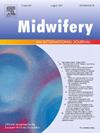The process of implementation of OMGP: staff experiences of service change
IF 2.6
3区 医学
Q1 NURSING
引用次数: 0
Abstract
Background
In 2023 our service introduced “OMGP”, the obstetric-medicine midwifery group practice model of care for women with complex medical care needs. OMGP is a collaborative, woman-centred model incorporating obstetrics, obstetric medicine, credentialled diabetes educators, and midwifery group practice.
Aim
To qualitatively explore knowledge and expectation of staff prior to its adoption and at a year post-implementation.
Methods
This study utilised profession-specific focus groups with OMGP staff (obstetricians, obstetric medicine physicians, credentialled diabetes educators, and midwifery group practice midwives) at baseline and 12 months post-implementation. Questions focused on understanding of and thoughts about the OMGP model of care, as well as important considerations for managing diabetes in pregnancy.
Findings
At baseline, the main theme relating to OMGP related to continuity of care. The main theme relating to how OMGP differs from usual models focused on enhanced benefits from interprofessional collaboration. Three themes existed around diabetes in pregnancy, including clinical knowledge, procedural concerns and professional boundaries. Initial expectations were broadly positive, acknowledging potential for scalability, but with caution regarding role clarity and adaption to change. A year following the model’s implementation, three themes were identified. These were: the benefits of a coordinated care delivery model, reflections and realisations, and embedding and strengthening, focusing on administrative/ procedural and systemic aspects of care delivery, highlighting areas for improvement and monitoring.
Conclusion
The insights of each professional group informed preparation for the launch of the model of care. Over time the model was successfully embedded, enhancing care coordination and delivery.
Statement of significance
Issue: Women with complex medical needs during pregnancy often experience fragmented and medicalised care, potentially leading to worse outcomes and less satisfaction with care.
What is already known: Continuity of midwifery care has been shown to improve birth outcomes and satisfaction with care for women. However, most evidence of the benefits of continuity of care exists for low to medium-risk cohorts, presenting a barrier to implementation of this model of care for higher medical risk women.
What this paper adds: This qualitative exploration of staff’s expectations and experience prior to and following the introduction of a collaborative, women focussed model of care for women at high medical risk. It revealed how, despite concerns regarding roles, processes, and clinical considerations, a shared goal of continuity of care and respect for interprofessional collaboration, strengthened relationships, interactions and care delivery can be achieved.
OMGP的实施过程:员工对服务变革的体验
2023年,我们的服务引入了“OMGP”,这是一种产科医学助产小组实践模式,为有复杂医疗需求的妇女提供护理。OMGP是一种以妇女为中心的协作模式,结合了产科、产科医学、有资格的糖尿病教育者和助产学团体实践。目的在实施前和实施后一年内定性地探讨员工的知识和期望。方法本研究在基线和实施后12个月对OMGP工作人员(产科医生、产科内科医生、有资格的糖尿病教育者和助产小组实践助产士)进行了专业特定的焦点小组调查。问题集中在对OMGP护理模式的理解和思考,以及管理妊娠糖尿病的重要考虑因素。基线时,与OMGP相关的主题与护理的连续性有关。主要的主题是OMGP与通常的模型的不同之处,它侧重于从跨专业协作中获得更多的好处。妊娠期糖尿病存在临床知识、程序关注和专业界限三个主题。最初的期望大体上是积极的,承认可扩展性的潜力,但在角色清晰度和适应变化方面要谨慎。在该模型实施一年后,确定了三个主题。这些是:协调的医疗服务模式的好处,反思和实现,嵌入和加强,关注医疗服务的行政/程序和系统方面,突出需要改进和监测的领域。结论各专业小组的见解为开展护理模式的准备工作提供了参考。随着时间的推移,这种模式被成功地嵌入,加强了护理协调和提供。问题:怀孕期间有复杂医疗需求的妇女往往会经历零散的医疗护理,这可能导致更糟糕的结果和更低的护理满意度。已知情况:持续的助产护理已被证明可以改善分娩结果和对妇女护理的满意度。然而,大多数证据表明,持续护理的好处存在于低至中等风险人群中,这对对医疗风险较高的妇女实施这种护理模式构成了障碍。本文补充的内容:这是对工作人员的期望和经验的定性探索,在引入以妇女为重点的合作模式之前和之后,为高医疗风险妇女提供护理。它揭示了尽管存在角色、流程和临床考虑方面的问题,但如何实现护理连续性和尊重跨专业合作、加强关系、互动和护理交付的共同目标。
本文章由计算机程序翻译,如有差异,请以英文原文为准。
求助全文
约1分钟内获得全文
求助全文
来源期刊

Midwifery
医学-护理
CiteScore
4.50
自引率
7.40%
发文量
221
审稿时长
13.4 weeks
期刊介绍:
Midwifery publishes the latest peer reviewed international research to inform the safety, quality, outcomes and experiences of pregnancy, birth and maternity care for childbearing women, their babies and families. The journal’s publications support midwives and maternity care providers to explore and develop their knowledge, skills and attitudes informed by best available evidence.
Midwifery provides an international, interdisciplinary forum for the publication, dissemination and discussion of advances in evidence, controversies and current research, and promotes continuing education through publication of systematic and other scholarly reviews and updates. Midwifery articles cover the cultural, clinical, psycho-social, sociological, epidemiological, education, managerial, workforce, organizational and technological areas of practice in preconception, maternal and infant care.
The journal welcomes the highest quality scholarly research that employs rigorous methodology. Midwifery is a leading international journal in midwifery and maternal health with a current impact factor of 1.861 (© Thomson Reuters Journal Citation Reports 2016) and employs a double-blind peer review process.
 求助内容:
求助内容: 应助结果提醒方式:
应助结果提醒方式:


